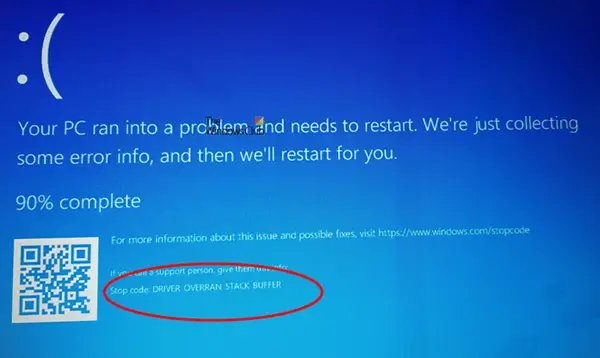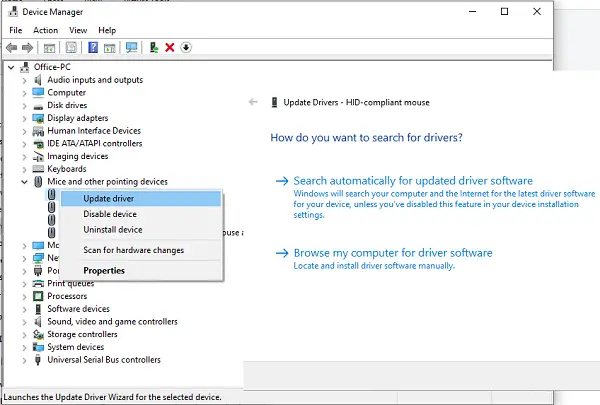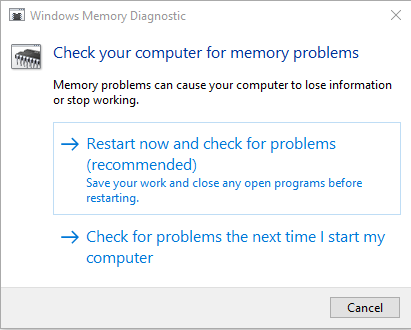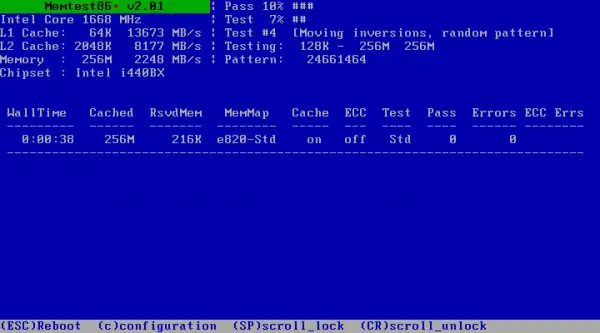If your Windows computer suddenly displays DRIVER OVERRAN STACK BUFFER, 0x000000f7 Blue Screen Stop Error on Windows 11/10, then this post can help you. This BSOD can occur during installation or after installing a Feature Update. System files like ntoskrnl.exe, hal.dll, nvlddmkm.sys, etc., may also be mentioned in the message.

0x000000f7 is a critical error displayed when Windows shuts down because of a kernel problem to prevent further damage to your computer. Says Microsoft about Bug Check 0xF7 DRIVER OVERRAN STACK BUFFER:
A driver overran a stack-based buffer (or local variable) in a way that would have overwritten the function’s return address and jumped back to an arbitrary address when the function returned. This is the classic “buffer overrun” hacking attack. The system has been brought down to prevent a malicious user from gaining complete control of it.
Causes of the error 0x000000f7 BSOD
- Mismatched memory modules – The installed memory modules are not of the same speed.
- Overclocked system – Your system clock is faster than its normal speed.
- Motherboard issue – Your motherboard has experienced a hardware issue and failed.
- Faulty RAM – One or more RAMs are corrupted or damaged.
- Driver issues – A device driver is either buggy or outdated.
Fix DRIVER OVERRAN STACK BUFFER Blue Screen
Now that you know this BSOD is useful in the way that it prevents a malicious user from gaining complete control. Follow the suggested solutions to get rid of the problem.
- Run Blue Screen Troubleshooter
- Uninstall recently installed Drivers or Software
- Update your drivers to the latest version
- Run Memory Diagnostics Tool
- Run MemTest86+ to analyze & test RAM
- Troubleshoot your installed RAM(s)
- Run System Restore.
Some of these solutions will need you to boot into Safe Mode while some of them can be performed using Advanced Recovery Options.
1] Use Online Blue Screen Troubleshooter Guide
If you cannot access Windows the usual way, boot into Safe Mode. Once there, log in using an admin account. Microsoft offers an online version of the Blue Screen Troubleshooter. We recommend you follow it as it provides multiple scenarios to resolve the issue. The offline version was removed in version Windows 10 v1809.
2] Uninstall recently installed Drivers or Software
Perform this in Safe Mode. If you had newly installed a drive before or after the feature update, then it would be a good idea to uninstall it.
- Figure out which software or driver you have installed recently. If the driver came with the software, it should be available in the installed program list.
- Use WIN + X + M to open Device Manager.
- Navigate to the device and right-click on it > Properties
- Switch to Drivers tab, see if you have the option to Rollback driver
- If yes, then click on it so it can restore the older version of the driver
- If you do not have the option to roll back, uninstall the device and then scan for hardware change.
- Windows should find the device again, use a generic driver
Restart, and this error should not occur again. However, you will still need to figure out the stable driver that works with the feature updates and install them.
Once resolved, we strongly suggest you read our guide on how you can backup and restore drivers.
3] Update your drivers to the latest version

You need to identify the driver which is causing this error. Many times drivers like ntoskrnl.exe, hal.dll, nvlddmkm.sys, etc are mentioned in the error screen.
An outdated driver may be causing this problem. So unlike the above step, you need to find the latest version of the driver and install it. You should do this when you are in the Safe mode. There are two ways of doing it:
- Windows Update – In the device manager, when you are on the Drivers tab, look for a button which says—Update Driver. Click on it, and it will look for a newer version of the driver using Windows Update.
- OEM Website – You can visit the OEM website and search the latest driver for the feature update. It is where you need to search based on your hardware device model and look for mention of compatibility. In case you have any confusion, get in touch with the support team and ask them with all the details. Once you have the driver setup, run it with admin privileges, and it should install the latest version of Driver.
Boot the computer in normal mode and check if the Driver Overran Stack Buffer error still occurs.
4] Run Memory Diagnostics Tool

Windows offers a Memory Diagnostics Tool that you can run to check if the issue is because of a possible memory problem.
- Make sure to save all your work before doing this.
- Type Memory Diagnostic in the search box, and click to open when it appears in the list.
- Click on Restart now and check for problems.
- If you do not want to run it right away, you can choose the second option.
- When the computer reboots next time, the diagnostic will run.
If any error is reported, make a note and see if you need to replace the RAM.
5] Run MemTest86+ to analyze and test your RAM

If the default Windows tool doesn’t show anything, then you need to run MemTest86+ to probe and test RAM. It is a free open source tool that performs extra diagnostics.
You will need to burn a bootable ISO and run the test after booting the computer from it. If the memory test gives you an error, you may need to change the RAM of the machine. Once done, you should no more receive Driver Overran Stack Buffer BSOD in Windows 11/10.
6] Troubleshoot your installed RAM(s)

If a faulty RAM is the cause of the BSOD, then you have to replace it. However, before doing this, you must be sure that the RAM is the cause, and you should know the specific RAM that’s faulty (if you have multiple modules installed).
To determine the bad RAM, remove all the installed modules, except one. Before taking out your RAM, shut down your computer entirely and unplug it from external power. You should also remove the computer’s battery to be sure because removing the RAM from a powered-on computer will cause more severe damage.
With only one RAM installed on your machine, power it on. If you don’t get the error 0x000000f7 BSOD with the RAM, you can tell that the RAM is good. Repeat this process with all of your RAM modules, and determine the specific RAM that brings up the error. This RAM has to be replaced to fix the BSOD issue.
On the other hand, if you get the error 0x000000f7 BSOD with every one of the RAMs you insert in a specific slot, that slot may be faulty. Otherwise, you can be sure that the problem isn’t caused by your RAM. If so, continue to the next method below.
7] Run System Restore
It is probably the last resort, and you can use either of the two options. System Restore is useful when the issue occurred after installing a new driver.
While the instructions are exhaustive, we hope you were able to resolve DRIVER OVERRAN STACK BUFFER BSOD in Windows 11/10.